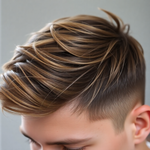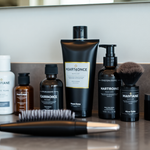
One Shade, More Outfits: How Semi‑Permanent Hair Color Cuts Waste and Expands Your Sustainable Men's Capsule Wardrobe
07 September 2025
Share
Struggling to look sharp without adding clutter? Meet the one-shade trick
One Shade, More Outfits: How Semi‑Permanent Hair Color Cuts Waste and Expands Your Sustainable Men's Capsule Wardrobe works because it solves a real problem many men face: a closet full of decent clothes but a daily fog of decisions and returns. Use one intentional, semi-permanent hair shade as a visual anchor and your existing pieces suddenly pair better, last longer in rotation, and generate less waste. This post shows you how to pick a shade, align your wardrobe, and measure the sustainability wins.
Why hair color matters more than you think
We tend to treat hair as separate from clothing, but human perception links color, contrast, and tone across the head-to-toe silhouette. Your hair is a permanent color block that sits above every outfit—so it either clashes or complements. Choosing a single, versatile shade makes the whole system coherent.
- Less cognitive load: When hair and wardrobe share a color language, dressing becomes faster.
- Fewer returns: Color mismatches lead to impulse purchases and returns, which create shipping emissions and extra packaging waste.
- Longer life for pieces: If clothes pair well together, you wear them more often instead of discarding or donating quickly.
One Shade, More Outfits: How Semi‑Permanent Hair Color Cuts Waste and Expands Your Sustainable Men's Capsule Wardrobe
This section lays out the exact mechanics. Semi-permanent hair color is the smartest choice for men building a sustainable capsule wardrobe because it is reversible, low-maintenance, and chemically lighter than permanent processes. The effect on your closet is measurable: better mix-and-match potential, fewer impulse buys, and more confidence to wear thrifted or long-lived pieces.
The science and perception behind coordinated color
Color harmony isn't just aesthetic—it's perceptual economy. Visual systems group items by hue, temperature, and contrast. When your hair tone acts as a stabilizing top-line hue, items below are read as part of the same ensemble. That means neutral garments feel more intentional, and accent colors look deliberate, which increases the number of usable outfit permutations.
Choosing the right semi-permanent shade: a step-by-step guide
Don't overcomplicate it. Follow this practical method to pick a shade that expands outfit options without forcing maintenance headaches.
- Audit your wardrobe by tone: Lay out 10 core pieces. Are they predominantly cool (navy, charcoal, black) or warm (camel, olive, brown)? Note the dominant undertone.
- Check your skin undertone: Look at your veins in natural light. Blue/purple veins suggest cool undertones; green-leaning veins suggest warm. Neutral is in-between. Use this to avoid shades that clash with skin.
- Pick one shade close to natural: For easy maintenance, choose a semi-permanent dye 1–2 shades different from your natural color. This limits stark regrowth lines and keeps the look believable.
- Test with a washable product: Try a color-depositing shampoo or a temporary rinse for a few washes to preview the outcome.
- Give it 2–3 wears: Observe how many different outfits now read more cohesive. If you see an uptick, it’s working.
Palette pairing: How to harmonize clothing with your chosen shade
Once you have a hair shade, tie your wardrobe to it with these tactics.
- Anchor neutrals: Make sure your primary jacket, shoes, and belt sit well with the hair tone. For example, warm brown hair complements camel, olive, and rust; cool ash tones work with navy, charcoal, and steel blue.
- Add two accent colors: Choose one warm and one cool accent that work with both your hair and neutrals. This increases outfit permutations without making the wardrobe loud.
- Textures over patterns: Texture acts like a safe accent. Wool, suede, and knit create depth without introducing new colors that might clash with the hair shade.
Build a sustainable capsule wardrobe that leverages one shade
Here’s a practical capsule checklist and how each item benefits from a consistent hair tone.
- 1 fitted jacket: A versatile jacket in navy or dark olive acts as the anchor for 70% of outfits.
- 2-3 shirts: Two tees (white and grey) and a button shirt in a coordinating shade.
- 2 trousers: One dark denim and one neutral chino.
- 1 knit: A sweater in tonal contrast for layering.
- 1 pair of shoes: Durable shoes in brown or black that match the hair-based palette.
With a single hair shade, these 8-9 items can produce 20-30 credible outfits instead of feeling repetitive.
12 outfit combinations that prove the point
Use these formulas to demonstrate how one shade multiplies outfits.
- White tee + dark denim + leather boots + fitted jacket
- Grey tee + chinos + suede derby + knit
- Button shirt + dark denim + sneakers + overshirt
- Neutral knit + navy jacket + chinos + boots
- Layered white tee + knit + jacket + jeans
- Monochrome charcoal: tee + jacket + trousers
- Smart-casual: button shirt + chinos + blazer
- Weekend: hoodie + denim + sneakers
- Travel outfit: performance tee + chinos + lightweight jacket
- Night out: dark shirt + jacket + slim jeans
- Summer smart: linen shirt + light chinos + loafers
- Cold weather: turtleneck + overcoat + boots
Each of these benefits when the hair shade reduces visual friction. You’ll notice pieces that once felt one-off now slot into multiple looks.
Maintenance and sustainability: low-effort ways to keep the system working
Semi-permanent color should reduce waste, not add to it. Follow these low-impact maintenance tips.
- Wash less: Shampooing 2-3 times per week preserves color and saves water. Dry shampoo is a useful tool.
- Use color-deposit products sparingly: A color-depositing conditioner every 1-2 weeks keeps tone rich without frequent dyes.
- Choose eco-minded products: Look for low-chemical or plant-based semi-permanent options to lower your personal chemical footprint.
- Regular trims: A 6-10 week trim keeps hair shape sharp so outfits look intentional, extending the life of your garments by preventing them from appearing dated or sloppy.
Environmental impact: small choices add up
Clothing returns and fast fashion churn have measurable environmental costs. Reducing returns and increasing the wear-rate of garments helps. For a broad look at textiles and waste, see EPA data on textiles and material-specific information: EPA - Textiles Material-Specific Data. Using semi-permanent hair color to make clothes work better together is an underappreciated sustainability tactic because it prevents unnecessary transactions and extends use.
Real-life case studies: two examples that scale
Short case study summaries to show outcomes.
- Sam, 28, hybrid worker: After switching from a high-contrast auburn to a soft brown semi-permanent shade, Sam reported halving his returns on online purchases and increased rotations of thrifted jackets from 2 to 5 wears per month.
- Marcus, 35, sales rep: Marcus used a cool ash rinse and reworked his capsule around navy and charcoal. He reduced wardrobe spending by 20% over six months and donated fewer items because he found improved synergy between pieces.
Shopping smart: what to buy, what to skip
When your hair anchors your look, shopping choices change. Here’s how to prioritize purchases that add real value.
- Invest in staples: Higher-quality jackets and shoes pay back through years of wear.
- Skip the trend treadmill: Trends often clash with stable hair tones and reduce mixability.
- Thrift with intent: When you try second-hand items, consider how they read with your hair. A consistent shade makes thrift finds more useful.
30-day experiment: a detailed program to test the system
Follow this month-long plan to measure how a single shade impacts your wardrobe and waste footprint.
- Week 1: Audit 30 days of outfit photos to quantify which pieces you wear most. Note color mismatches that cause you to avoid garments.
- Week 2: Try a semi-permanent shade close to your natural color. Use a temporary rinse for confidence. Build 5 outfit formulas and wear them for the rest of the week.
- Week 3: Track emotional comfort, time spent deciding, and any returns avoided. Replace one worn-out item with a versatile staple only if necessary.
- Week 4: Review outcomes. Count outfits created from core pieces and calculate any reduced spending or returns. If the experiment increases outfits and decreases purchases, the strategy is validated.
FAQ: common questions answered
- Will semi-permanent color damage my hair? No more than regular styling if you choose low-chemical products and follow recommended usage. For safety notes, see WebMD on hair coloring: WebMD - Hair Coloring Safety.
- How often will I need to touch up? Semi-permanent fades over 4-8 weeks; maintenance varies with wash frequency and sunlight exposure.
- Is this approach only for certain ages? No. Men aged 18-45 can all benefit because the tactic is about visual coherence, not age-specific style.
Practical product suggestions and Menll.com integration
Small product choices support this strategy. Use color-depositing conditioners, a reliable dry shampoo, and invest in a durable pair of shoes that match your chosen palette. Menll.com offers versatile staples that pair well with a one-shade system—like the EcoSneak Casual Shoes and hard-wearing outerwear designed for long life. Browse Menll.com’s outerwear collection for jackets that play well with a single hair palette: Menll.com Outerwear Collection. You can also read more about building a capsule wardrobe on Menll.com’s blog: How to Build a Capsule Wardrobe.
Measuring your wins: what success looks like
Track these KPIs to know the approach is working:
- Number of wearable outfit combinations from core items (target: +25-50% in one month)
- Reduction in returns and impulse purchases
- Increased use of thrifted or long-lived pieces
- Less time deciding what to wear each morning
Final thoughts and one action to try today
Semi-permanent hair color is a subtle, reversible change that pays big dividends for men building a sustainable capsule wardrobe. One Shade, More Outfits: How Semi‑Permanent Hair Color Cuts Waste and Expands Your Sustainable Men's Capsule Wardrobe is more than a headline—it’s a practical strategy to reduce waste, save money, and get dressed faster. Start with a temporary rinse and test three outfit formulas this week.
Which outfit formula will you try first? Share your results in the comments or browse Menll.com for durable staples that match your one-shade strategy.
Vorheriger Beitrag

Mono-Hue Strategy: Semi-Permanent Hair Color to Streamline Your Sustainable Men's Capsule Wardrobe
Aktualisiert am 08 September 2025
Nächster Beitrag

Low-Waste Color Lab: Experiment with Semi‑Permanent Hair Color to Optimize Your Sustainable Men's Capsule Wardrobe
Aktualisiert am 06 September 2025





